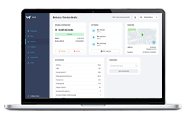Electric vehicles (EV)
At the moment, there are about 1,8 million electric vehicles in Europe. The European Union aims to have a least 30 million zero-emissions cars on its roads by 2030, requiring the construction of more than 3 million charging points, against the 200 000 in place at the moment.
The biggest challenge facing EV adoption is currently the relatively low range EVs are able to provide on a single charge, in comparison to traditional petrol engines (about 350 km vs 500 km on an average charge/tank). The second issue is the duration it takes to provide that single charge. Both aspects make the investment in charging infrastructure enormously important for society.
V2X technology can provide information on the speed of the vehicles ahead, adjusting the speed accordingly. Wasteful braking and accelerations are prevented
V2X can increase an electric vehicle's range. Although being primarily linked to the EV's battery range, the rate of discharge is affected by several factors on highways:
High speed significantly increases energy lost, due to air drag because of the extended distance between cars, necessary to ensure safety and enable stopping in the event of an emergency
In cities, energy is also wasted on accelerations between traffic lights and the continuous stopping and starting.
By applying all the V2X factors above, the energy saving can reach up to 30%. The resultant economy in relation to the installation of more than 900 000 EV charging stations could realise up to 30 billion euros.
Speed and acceleration activity consumes a lot of power as the speed of highway traffic often fluctuates
V2X can also safely reduce the distance between cars at high speeds and improve airflow.
When vehicles are in cities, most EVs can save energy by applying the optimal speed via V2X sensors to best match the vehicle's acceleration and deceleration to the phasing of traffic lights
V2X technology can resolve the challenges mentioned above:







Read more...
Road telecommunication element designed to build a V2X technology data transmission transmission network between road traffic objects
RSU–R1
RSU unit

Read more...
Read more...
V2X applications, services and communication stack for OBUs enable the opportunities provided by V2X technology
Complete V2X on-board unit incloses highly integrated V2X cast software: including the standard compliant V2X stack advanced IEEE
Software for OBU
OBU–V1
Software
OBU unit

Read more...
V2X integration platform (V2AP) – is a server-side software enabling V2X services to improve safety and efficiency
V2AP
Software
Read more...
V2X applications, services and communication stack for RSUs enable the opportunities provided by V2X technology
Software for RSU
Software
Electric Vehicles (EV)
By applying all the V2X factors above, the energy saving can reach up to 30%. The resultant economy in relation to the installation of more than 900 000 EV charging stations could realise up to 30 billion euros.
V2X can also safely reduce the distance between cars at high speeds and improve airflow.
When vehicles are in cities, most EVs can save energy by applying the optimal speed via V2X sensors to best match the vehicle's acceleration and deceleration to the phasing of traffic lights
V2X technology can provide information on the speed of the vehicles ahead, adjusting the speed accordingly. Wasteful braking and accelerations are prevented
V2X technology can resolve the challenges mentioned above:
In cities, energy is also wasted on accelerations between traffic lights and the continuous stopping and starting.
High speed significantly increases energy lost, due to air drag because of the extended distance between cars, necessary to ensure safety and enable stopping in the event of an emergency
Speed and acceleration activity consumes a lot of power as the speed of highway traffic often fluctuates
V2X can increase an electric vehicle's range. Although being primarily linked to the EV's battery range, the rate of discharge is affected by several factors on highways:
The biggest challenge facing EV adoption is currently the relatively low range EVs are able to provide on a single charge, in comparison to traditional petrol engines (about 350 km vs 500 km on an average charge/tank). The second issue is the duration it takes to provide that single charge. Both aspects make the investment in charging infrastructure enormously important for society.
At the moment, there are about 1,8 million electric vehicles in Europe. The European Union aims to have a least 30 million zero-emissions cars on its roads by 2030, requiring the construction of more than 3 million charging points, against the 200 000 in place at the moment.






Read more...
V2X applications, services and communication stack for OBUs enable the opportunities provided by V2X technology
Software for OBU
Software
Read more...
V2X applications, services and communication stack for RSUs enable the opportunities provided by V2X technology
Software for RSU
Software
RSU unit
RSU–R1
Road telecommunication element designed to build a V2X technology data transmission transmission network between road traffic objects.
Read more...

OBU unit
OBU–V1
Complete V2X on-board unit incloses highly integrated V2X cast software: including the standard compliant V2X stack advanced IEEE.
Read more...

Software
V2AP
V2X integration platform (V2AP) – is a server-side software enabling V2X services to improve safety and efficiency.
Read more...

